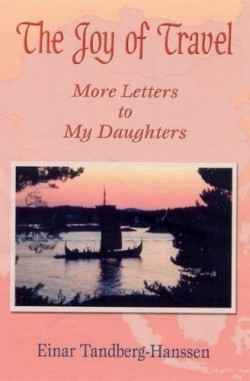The Joy of Travel
More Letters to My Daughters
It is unusual to read a book that is such a combination of information and introspection that it cannot be categorized. Letters, on the other hand, are often complex mixtures of the surroundings, thoughts, and background of their writers. With The Joy of Travel: More Letters to my Daughters, Tandberg-Hanssen cleverly utilizes the structure of the latter to accomplish the former.
This compilation of some twenty-five pieces, which recount the author’s travels throughout Europe and parts of South America, Asia, and the United States, is formatted as letters and notes to his two adult daughters. Writing in this familiar style affords the author opportunity to include personal experiences such as “swimming at that beautiful beach…in the warm water of the Gulf” (of Patras, in Greece), as well as history, literary observations, and geographical data.
Much of the book—eleven of the twenty-five essays—is focused on Paris and other French cities, and the author notes, “It is no secret that I like France.” But there are also descriptive accounts of business trips and sightseeing adventures in Argentina, Italy, India, Norway, and New Orleans.
An obviously intelligent individual, Tandberg-Hanssen is an astronomer who has also written a book on astronomical physics, and has contributed to various scientific articles. But this book and its prequel, Letters to My Daughters, released in 2004, show that travel is, if not the author’s first love, then at least his second. His musings on historical landmarks and significant historic and literary locales show a knowledge that goes beyond most travel guides. In one Paris letter, he quotes Whitman, Virgil, and eighteenth century French political writer Montesquieu. Later, writing from Winchester, he gives readers a quick lesson in old English history, throwing in some facts about Germany and Rome for good measure. He mixes all this with architectural observations, which are no less astute:
Today (Winchester) is dominated by its magnificent cathedral…In 634 Bishop Birinus came from Rome and converted West Saxons to Christianity, and Bishop—later Saint—Svithun built a wall around the cathedral close, a wall that saved townspeople from Danish Vikings in 860.
Then, on a more personal note, he adds, “Today, as I approached the cathedral, I saw, on the wide green lawns around it, people picnicking, some just stretching out and soaking in the sunshine.”
The book finishes with an appendix of “retrospective letters,” written about travels the author took from 1952 to 1985. These, as with other sections of the book, are accompanied by basic but helpful maps drawn specifically for the author by Andrea Gray.
At times, one can feel almost as if there is too much information here to digest. But given time, and a reader’s curiosity, the portions are edible—and sometimes downright delicious.
Reviewed by
Lori Cossens-Richardson
Disclosure: This article is not an endorsement, but a review. The publisher of this book provided free copies of the book to have their book reviewed by a professional reviewer. No fee was paid by the publisher for this review. Foreword Reviews only recommends books that we love. Foreword Magazine, Inc. is disclosing this in accordance with the Federal Trade Commission’s 16 CFR, Part 255.

